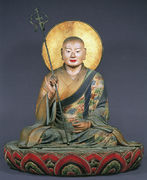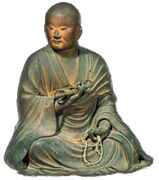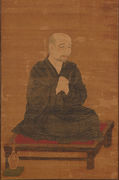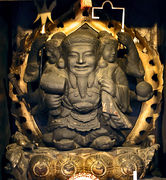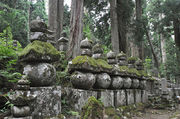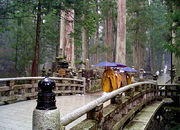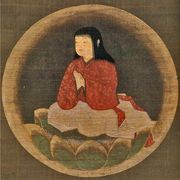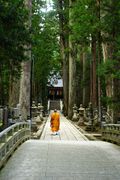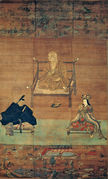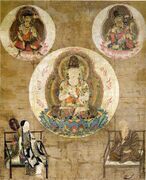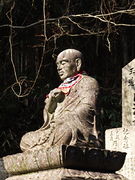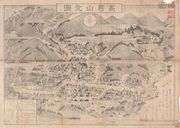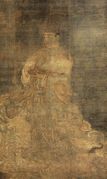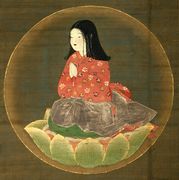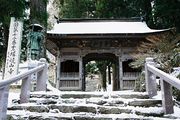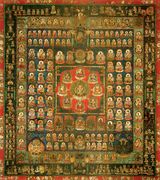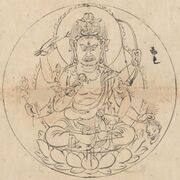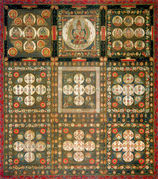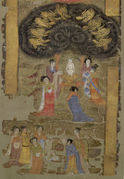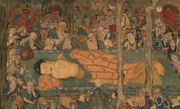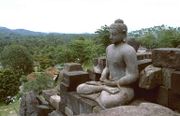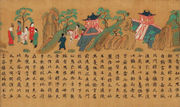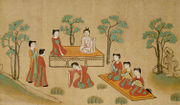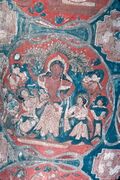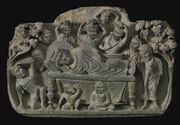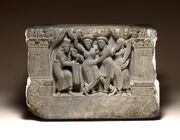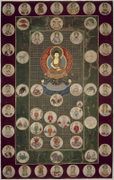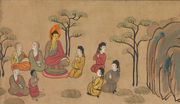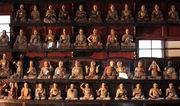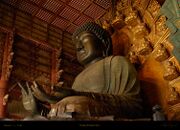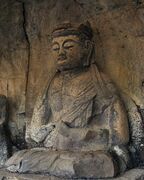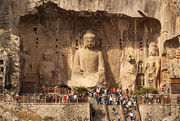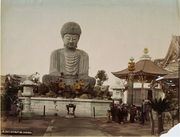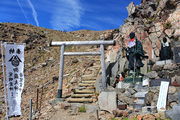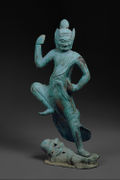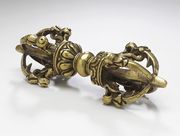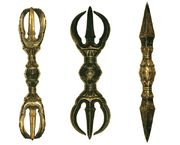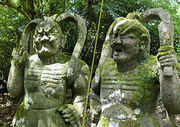Kūkais Initiation
Achtung: Sie sehen eine veraltete Version von https://religion-in-japan.univie.ac.at/Handbuch/Geschichte/Kukai/Kukais_Initiation.
Achtung: Sie sehen eine veraltete Version von https://religion-in-japan.univie.ac.at/Handbuch/Geschichte/Kukai/Kukais_Initiation.
In einem Bericht, den
774–835, Gründer des Shingon Buddhismus; Eigennamen Saeki Mao, Ehrennamen Kōbō Daishi
Der Begriff „Kūkai“ wird in diesem Handbuch auf folgenden Seiten erwähnt:
Glossarseiten
Bilder
nach seiner Rückkehr aus China für den kaiserlichen Hof verfasste, beschreibt er die mys·ti·schen Er·leb·nisse sei·ner Ini·tia·tion in den esoterischen Buddhismus unter sei·nem chi·ne·si·schen Meis·ter Huiguo [Huiguo (chin.) 惠果 746–806; ältere Schreibung Hui-kuo; chin. Lehrer Kūkais] fol·gen·der·maßen:
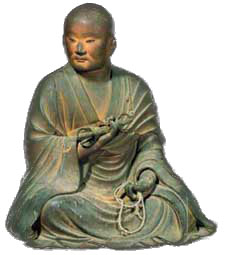
Holzstatue, Kamakura-Zeit.
One day, in the course of my calls on eminent Buddhist teachers of the capital, I happened by chance to meet the abbot of the East Pagoda Hall of the Green Dragon Temple. This great priest, whose Buddhist name was Hui-kuo, was the chosen disciple of the Indian master Amoghavajra. His virtue aroused the reverence of his age; his teachings were lofty enough to guide emperors. Three sovereigns revered him as their master and were ordained by him. The four classes of believers looked up to him for instruction in the esoteric teachings.
I called on the abbot in the company of five or six monks from the Hsi-ming Temple. As soon as he saw me he smiled with pleasure, and he joyfully said, 'I knew that you would come! I have been waiting for such a long time. What pleasure it gives me to look on you today at last! My life is drawing to an end, and until you came there was no one to whom I could transmit the teachings. Go without delay to the ordination altar with incense and a flower.' I returned to the temple where I had been staying and got the things which were necessary for the ceremony. It was early in the sixth moon, then, that I entered the ordination chamber. I stood in front of the Womb„Kreis“, schematische Darstellung der kosmischen Ordnung (jap. mandara 曼荼羅)
Der Begriff „mandala“ wird in diesem Handbuch auf folgenden Seiten erwähnt:
Glossarseiten
Bilder
Der Begriff „Buddha“ wird in diesem Handbuch auf folgenden Seiten erwähnt:
Glossarseiten
Bilder
„Sonne, sonnenhaft“, Buddha-Name (jap. Birushana/Rushana 毘盧舎那/盧舎那 oder Dainichi 大日)
Der Begriff „Vairocana“ wird in diesem Handbuch auf folgenden Seiten erwähnt:
Bilder
in the centre. The master exclaimed in delight, 'How amazing! How perfectly amazing!' He repeated this three or four times in joy and wonder. I was then given the fivefold baptism and received the instruction in the Three Mysteries that bring divine intercession. Next I was taught the Sanskrit formulas for the Womb Mandala, and learned the yoga contemplation on all the Honoured Ones.Early in the seventh moon I entered the ordination chamber of the Diamond [
„Donnerkeil“, Ritualinstrument und Symbol des tantristischen/esoterischen Buddhismus (jap. kongō 金剛)
Der Begriff „vajra“ wird in diesem Handbuch auf folgenden Seiten erwähnt:
Bilder
] Mandala for a second baptism. When I cast my flower it fell on Vairocana again, and the abbot marvelled as he had before. I also received ordination as an acharya early in the following month.
Quelle:
S. 144-46. [Jap. Originaltext: Kobo Daishi Zenshu I: 98 ff.]
Religion in Japan, Inhalt
- 一 Grundbegriffe
- 二 Bauten
- 五 Mythen
- Einleitung
- Mythologie:
- Götter des Himmels
- Götter der Erde
- Jenseits:
- Jenseits
- Geister:
- Totengeister
- Dämonen
- Tiere:
- Imaginäre Tiere
- Verwandlungskünstler
- Symboltiere
- 六 Geschichte
- Einleitung
- Altertum:
- Prähistorie
- Frühzeit
- Nara-Zeit
- Frühe kami-Kulte
- Heian-Zeit
- Saichō
- Kūkai
- Honji suijaku
- Mittelalter:
- Kamakura-Zeit
- Amidismus
- Zen Buddhismus
- Nichiren Buddhismus
- Mittelalterl. Shintō
- Frühe Neuzeit:
- Reichseinigung
- Christentum
- Terauke-System
- Neo-Konfuzianismus
- Kokugaku
- Moderne und Gegenwart:
- Bakumatsu-Zeit
- Staatsshintō
- Neue Religionen
- 七 Essays
- Überblick
- Buddhismus, Asien:
- Arhats in China und Japan
- Vajrapani: Der Feldherr des esoterischen Buddhismus
- Bishamon-ten: Wächter und Glücksgott
- Riesen-Buddhas: Im Kampf gegen die Unbeständigkeit des irdischen Daseins
- Lokale Vorstellungen, Japan:
- Jindō und shintō: Zum Begriffsinhalt des ‚Weges der kami‘
- Ōkuninushi als heimlicher Gegenspieler der Himmlischen Götter
- Religiöse Gewalt in Japan: Blutopfer, Selbstopfer, Menschenopfer
- Unterhändler des Imaginären: Regenmachen im vormodernen Japan
- Lieber das Herz in der Hand als die Taube über dem Heer
- Feuer mit Feuer bekämpfen: Der Gehörnte Meister und sein Kult
- Hundert Geschichten: Horrorklassiker aus der Edo-Zeit
- Religion und Politik:
- Die Tenshō-Mission: Beginn einer schwierigen transnationalen Beziehung
- Yasukuni: Der Schrein des ‚friedlichen Landes‘
- Herrigels Zen und das Bogenschießen
- Anhang
- Metalog
- Konzept
- Autor
- Impressum
- Glossare
- Fachbegriffe-Glossar
- Bilder-Glossar
- Künstler-Glossar
- Geo-Glossar
- Ressourcen
- Literatur
- Links
- Bildquellen
- Suche
- Suche
- Feedback
- Anmelden
„Kūkais Initiation.“ In: Bernhard Scheid, Religion-in-Japan: Ein digitales Handbuch. Universität Wien, seit 2001
